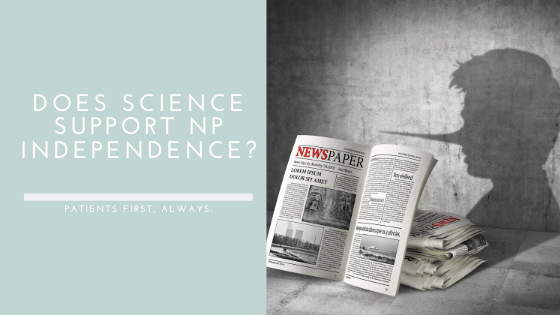Fifty Years of NP Research, Huh?

This is a reprint from a review done and published at the Physicians for Patient Protection website. The picture above is a Wayne’s World reference to a famous commercial in the 1970s. You may or may not get it.
No author here at Authentic Medicine is a member of PPP. The doctor there who wrote this had to remain anonymous to protect his/her career. Why? Because we are in a world where there seems to be no rules in regards to destroying a physician’s reputation.
What we keep hearing (from the AANP) is that they have 50 years of research backing up their promise that NPs are as good or better than doctors. If

Grave Concerns about the Misrepresentation of Science
I began a project to review the original research articles in the annotated bibliography of the American Association of Nurse Practitioner’s (AANP) position paper, “Quality of Nurse Practitioner Practice”. I wanted to investigate their claim that “Nurse Practitioner care is comparable in quality to that of their physician colleagues.” I quickly realized that the research synopses provided by the AANP were incredibly misleading, based on the articles presented.
Brief Overview of Problems
I will provide a brief overview of some specific misleading claims made by the AANP. For example, AANP cites studies in which physicians were involved in the patient care, yet they attribute the benefit to Nurse Practitioners (NPs), even when it isn’t clear whether it was the NP or the physician who performed critical tasks for the patient.
AANP also cites studies that are too small to draw any conclusions.
AANP cites such studies as showing definitive proof of their equivalence claim by either omitting key details or blatantly misinterpreting the statistics, which seems highly unethical.
Deeper Dive into Specific Studies
The AANP concludes that the study, Ettner et al., 2006, found that a “physician-NP team achieved significant cost savings … compared to the control group, while the outcomes … were comparable”, implying that a team with an NP had equal outcomes with lower cost. They conveniently omit that the “physician-NP team” intervention added additional physicians to the team, along with NPs (2 attending physicians, 4 resident physicians and 6 interns vs. 2 attendings, 4 residents, 6 interns + physician director + extra attending physician time + 2 NPs [working 27% of hours/week]). A team with more physicians and with NPs only working 27% of the work hours was used to claim comparable outcomes and “significant” cost savings over a team with all physicians.
Similarly, from Gracias et al., 2008, the AANP concludes “that clinical practice guideline adherence was significantly higher among patients belonging to the NP team.” The AANP neglects to mention that this study was designed to test a new ICU treatment model, and that NPs didn’t replace physicians in any way. In the old model, an intensivist physician and a surgeon both placed patient care orders with the help of resident physicians. In the new model, the intensivist physician was placed in charge, while the surgeon provided consultation. An NP was added to the team of resident physicians, and this physician-led team was called the “NP team.”
Both of these studies added NPs to a physician-led treatment team, but also changed much more than just adding an NP or two. The AANP reports the results as if benefits could be definitively attributed to adding NPs. They mislead the public by omitting the physician leadership, and by omitting major changes in team process which may have driven the noted benefits.
Comparable, Superior, or Neither? Statistics 101
The AANP presents several articles using the word “comparable” to describe care outcomes of NPs and physicians, including the following publications: Borgmeyer et al., 2008; Cooper et al., 2002; Lenz et al., 2004.
The AANP’s interpretation of the results of these studies as “comparable” is based on a misleading and incorrect interpretation of statistics. These studies were designed to test whether one of the groups was superior to the other, but they failed to find superiority.
A failure to find superiority does not mean that the groups are comparable. The AANP should know better, but the general public, many of whom have no statistics training, may not understand this distinction.
These studies were underpowered (had too few subjects) to find superiority, and thus no conclusions should be drawn from them. In addition, in all of these studies, physicians provided a substantial component of the care to the patients, completely confounding the results.
Confounded Groups and Poor Statistical Reporting
Similarly, Sackett et al., 1974, is reported as having “comparable” outcomes between NPs and physicians; however, this study is replete with flaws making it impossible to accurately interpret:
- The statistical tests used by the investigators are not reported.
- There are 3 primary “health status” outcomes, but there is no statistical correction made for these multiple comparisons.
- Beta is not reported for the mortality outcome, meaning that no conclusion of equivalence can be justified.
- Physicians are reported to have seen patients at about 1/3 of the NP visits during the last two months of the study period, but the number of NP visits where a physician was involved prior to that was not reported.Obviously, having a physician involved in the patient care, rather than just the NP, confounds the data and makes it impossible to conclude anything about NP care.
Sacket et al., 1974, cannot be a legitimate and honest basis for claims regarding NP independent practice. In addition, in 1974, NPs were all working directly with physicians. There was no independent NP practice in that decade.
Meta-Analysis Reveals Flaws in AANP Reasoning
The AANP states that Laurant et al., 2006 found care between nurses and physicians were “equivalent.” However, that Laurant meta-analysis found that “only one study was powered to assess equivalence of care”, and it was this one: Lattimer et al., 1998, a study of nurses (not NPs) providing first phone contact after-hours, with a physician immediately available and accessed for approximately half of the phone calls.
We learned from Lattimer that nurses can handle patient phone calls after-hours, with physician back-up, but learned nothing about the quality of NP care from that study, despite AANP claims to the contrary.
More Confounding of Data
The AANP presents Mundinger et al., 2000, a randomized controlled trial of NP vs. physician primary care, as finding “comparable” health outcomes between the two groups. Although this article claims to be adequately powered to find meaningful differences in self-reported health outcomes between physician and NP primary care, confounders make the results of this study uninterpretable.
The authors later even critique their own prior research. In a follow-up paper from the same two lead authors (Lenz, Mundinger, et al., 2004), the authors critique the method of analysis used in the original paper: “approaches, such as an intention-to-treat analysis including all randomized participants, would have increased the statistical power. However … such analyses would have greatly favored the null hypothesis [NP/Physician equivalence] … by including participants who had changed practices during the study.” This paper is also confounded by the fact that the patients all received emergency or urgent medical care on the day of their baseline survey, almost certainly cared for at that time by a physician.
A Challenge to Do Better
I challenge the AANP to present only articles that support their claim that “NP care is comparable in quality to that of their physician colleagues” in a manner that is statistically justified. These trials should be randomized and controlled with equivalent patient populations in both treatment groups. NPs alone should be responsible for diagnosis and treatment pertinent to the outcomes studied. If specialist/emergency/hospital care is made, it should be accounted for as a confounder. If the trials are designed as superiority trials, they should only be touted if a finding of superiority is justified. For claims that care is “comparable,” the trial should be designed as an equivalence study and adequately powered. If multiple primary outcomes are identified, multiple comparisons should be corrected for in the statistical analysis. If a finding is in fact justified, the external validity should be clearly identified, including the patient population and setting of care.
If the AANP cannot find and show these studies, I urge them to fund these studies through a neutral intermediary and retract their misleading statements regarding NP and physician equivalence.
Finally, I support solving physician shortages with physicians.
–A Physician (Scientist) for Patient Protection
There you have it. We believe this situation is very concerning, especially with the NP and DNP online diploma mills that are exploding in popularity and putting out lesser qualified NPPs (non physician practitioners). This is a major safety concern and we hope an open debate occurs between the PPP and the AANP.
Get our awesome newsletter by signing up here. We don’t give your email out and we won’t spam you









Well done.
There is no doubt in my mind that the quality of care provided by physicians is far superior to that of non-physicians.
I have been frequently criticized for stating there is no short cut to practicing medicine. The only pathway is to attend medical school.
“Lies, Damn Lies, and Statistics” … Seems they’ve hit about all of them!
Wow! This is a major problem. How do we fix this? Physicians do what they do. Their supporting organizations have no backbone. ??????????????????????? NP’s are well organized. Political pressure and substandard skill will supersede clinical skills and competence. Go Medicine! NP’s. Get a lot more training. You don’t know what you don’t know.